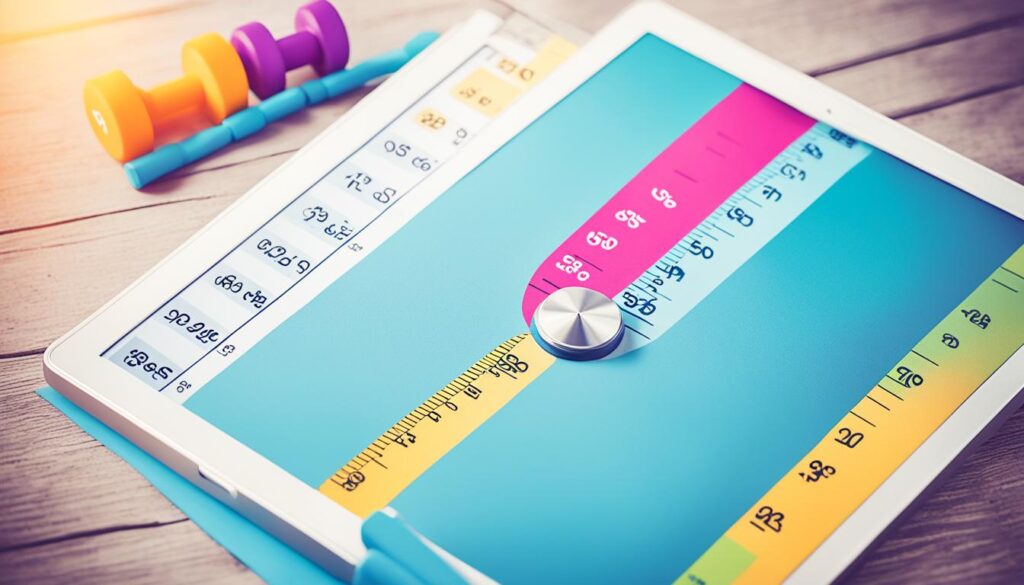Are you considering the HCG diet for weight loss? While the HCG diet can be an effective way to shed pounds, it’s essential to understand the importance of exercise modifications during each phase. But here’s the burning question: how can you adapt your exercise routine to ensure safety and effectiveness while following the HCG diet?
In this article, I will guide you through the different phases of the HCG diet and provide expert advice on exercise modifications. From the loading phase to the maintenance phase, you’ll discover the best workout strategies to maximize your weight loss results without jeopardizing your health.
Key Takeaways:
- Exercise modifications are crucial for safety and effectiveness during the HCG diet.
- Low impact activities are recommended during the calorie restriction phase to preserve muscle mass.
- Gradual progression is important when incorporating exercise into the HCG diet.
- Monitoring and adjusting exercise on the HCG diet can optimize results.
- Maintaining weight after the HCG diet requires ongoing exercise and lifestyle changes.
Understanding the HCG Diet
The HCG diet is a weight loss program developed by Dr. Simeon that combines HCG injections with a low calorie diet. HCG, or Human Chorionic Gonadotropin, is a hormone naturally produced during pregnancy that helps mobilize stored fat in the body for energy. The diet typically involves consuming around 500-800 calories per day and is divided into multiple phases. Before making exercise modifications, it is essential to have a basic understanding of the HCG diet and its principles.
The HCG diet primarily focuses on calorie restriction to induce weight loss. By limiting daily calorie intake, the body is forced to utilize stored fat for energy, resulting in fat loss. The addition of HCG injections helps to speed up the fat mobilization process, maximizing the effectiveness of the diet.
It is important to note that the HCG diet is a medically supervised program and should be followed under the guidance of a healthcare professional. The low calorie intake and hormone injections require careful monitoring to ensure safety and optimal results.
To visualize the basic structure of the HCG diet, refer to the table below:
| Phase | Duration | Calorie Intake |
|---|---|---|
| Phase 1 – Loading Phase | 2 days | High calorie |
| Phase 2 – Calorie Restriction Phase | 21-42 days | 500-800 calories |
| Phase 3 – Stabilization Phase | 21 days | Gradual increase in calorie intake |
| Phase 4 – Maintenance Phase | Ongoing | Steady calorie intake |
Note: The duration and calorie intake of each phase may vary based on individual circumstances and healthcare professional’s recommendations.
During the calorie restriction phase, it is crucial to make exercise modifications to ensure safety and maximize results. The next section will delve into the benefits of exercise on the HCG diet and provide specific exercise modifications for each phase of the diet.
Benefits of Exercise on the HCG Diet

While the HCG diet primarily focuses on calorie restriction, incorporating exercise into the program can have numerous benefits. Exercise can help preserve muscle mass, increase the metabolic rate, improve overall well-being, and enhance weight loss results. However, it is essential to modify exercises to ensure safety and prevent muscle loss during the different phases of the HCG diet.
Regular physical activity not only supports weight loss but also plays a crucial role in maintaining long-term success. By engaging in exercise while following the HCG diet, individuals can experience the following benefits:
- Preservation of Muscle Mass: Exercise helps preserve lean muscle tissue while on a calorie-restricted diet. This is important because muscle is metabolically active, meaning it burns calories even at rest. By preserving muscle mass, the body can maintain a higher metabolic rate, which can contribute to sustainable weight loss.
- Increased Metabolic Rate: Exercise stimulates the metabolism, leading to an increase in the number of calories burned. This can help offset the decrease in calorie intake during the HCG diet and support weight loss.
- Improved Overall Well-being: Physical activity releases endorphins, which are known as “feel-good” hormones. These hormones promote feelings of happiness, reduce stress, and improve overall mental well-being.
- Enhanced Weight Loss Results: Combining exercise with the HCG diet can maximize weight loss results. Exercise helps create a calorie deficit, resulting in more efficient fat burning and increased weight loss.
“Incorporating exercise into the HCG diet can offer a range of benefits that go beyond weight loss. Regular physical activity promotes muscle preservation, boosts the metabolic rate, improves emotional well-being, and reinforces the weight loss achieved through the HCG diet.”
When modifying exercises for the HCG diet, it is important to prioritize safety and prevent muscle loss. Low-impact activities such as brisk walking, cycling, swimming, and yoga are excellent options that minimize joint stress while still providing cardiovascular benefits. Additionally, incorporating strength training exercises with light weights or resistance bands can help maintain muscle mass.
By incorporating exercise into the HCG diet, individuals can optimize their weight loss journey, improve their overall well-being, and achieve long-lasting results. However, it is always recommended to consult with a healthcare professional before starting any exercise regimen to ensure safety and effectiveness.
Exercise Modifications for Phase 1 – Loading Phase
During the loading phase of the HCG diet, the main focus is on consuming a high-calorie diet to prepare the body for the upcoming calorie restriction phase. At this stage, exercise modifications are not necessary. However, engaging in light to moderate exercises can still be beneficial for muscle development and overall fitness.
While the loading phase is meant for weight gain, it is important to prioritize muscle development over fat accumulation. Incorporating exercises that target multiple muscle groups can help promote lean muscle growth and improve strength.
Note: It is essential to consult with a healthcare professional or a qualified fitness expert before starting any exercise regimen on the HCG diet to ensure that it aligns with your specific health needs and goals.
Benefits of Light to Moderate Exercises During the Loading Phase:
- Promotes muscle development and strength
- Improves overall fitness
- Prepares the body for the upcoming phases of the HCG diet
While there are no specific exercise restrictions during the loading phase, it is important to listen to your body and avoid any exercises that cause discomfort or strain. Focus on low impact exercises such as walking, swimming, or gentle stretching to promote muscle growth without excessive stress on the body.
Remember, the loading phase is a crucial period for muscle development and preparation. Although exercise modifications are not necessary, engaging in light to moderate exercises can contribute to improved overall fitness and lay the foundation for a successful HCG diet journey.
In the next section, we will discuss the exercise modifications recommended for the calorie restriction phase of the HCG diet.
Exercise Modifications for Phase 2 – Calorie Restriction Phase
In the HCG diet, the calorie restriction phase is the main phase where individuals consume a very low-calorie diet. During this phase, it is crucial to modify exercises to low impact activities that focus on preserving muscle mass and supporting overall well-being.
While intense cardio or strength training may not be suitable during the calorie restriction phase, there are plenty of low impact exercises that can be incorporated to maintain muscle and enhance the effectiveness of the HCG diet.
Examples of Low Impact Exercises:
- Walking: A simple yet effective exercise, walking can be easily incorporated into your daily routine. Aim for brisk walks to elevate your heart rate and maximize calorie burn.
- Swimming: Swimming is a great low impact exercise that engages multiple muscle groups while putting minimal stress on your joints. It provides a full-body workout and helps improve cardiovascular fitness.
- Pilates: Pilates exercises focus on core strength, flexibility, and body awareness. It is a low impact exercise that can be performed using a mat or specialized equipment and is ideal for muscle toning and overall body conditioning.
- Yoga: Yoga combines physical postures, breathing exercises, and meditation to promote strength, flexibility, and mental well-being. It offers a gentle yet effective way to maintain muscle tone and improve balance and coordination.
By incorporating these low impact exercises into your routine during the calorie restriction phase, you can prioritize muscle preservation while still benefiting from physical activity.
Remember, the calorie restriction phase requires a focus on maintaining muscle mass rather than intense workouts. Choose exercises that are gentle on your body and align with the principles of the HCG diet. Always listen to your body and consult with a healthcare professional before starting any exercise routine.
Exercise Modifications for Phase 3 – Stabilization Phase

During the stabilization phase of the HCG diet, the focus shifts towards gradually increasing calorie intake and reintroducing a wider variety of foods back into the diet. This phase is crucial for transitioning into a more sustainable eating pattern and maintaining the weight loss achieved in the previous phases. In addition to dietary adjustments, incorporating exercise modifications is essential to support muscle development and overall well-being.
“The stabilization phase is a critical period where individuals can rebuild and strengthen their muscles while adjusting to a higher calorie intake,” says Dr. Amanda Johnson, a renowned nutritionist and HCG diet expert. “Exercise modifications during this phase can help boost metabolism, improve muscle tone, and support long-term weight management.”
Strength training exercises are particularly beneficial during the stabilization phase. By incorporating resistance training with weights or resistance bands, individuals can stimulate muscle growth and enhance overall body composition. This not only helps improve muscle tone but also increases the metabolic rate, leading to a more efficient calorie burn.
Here are some exercise modifications to consider during the stabilization phase of the HCG diet:
- Include resistance training exercises such as squats, lunges, chest presses, and rows, to target major muscle groups.
- Gradually increase the weight or resistance over time to promote ongoing strength gains.
- Perform compound exercises that engage multiple muscle groups simultaneously for maximum efficiency.
- Consider incorporating circuit training, alternating between strength exercises and short bursts of cardio, to maximize calorie burn and elevate the heart rate.
By incorporating these exercise modifications, individuals can continue to build strength and support their weight loss journey during the stabilization phase of the HCG diet.
| Exercise | Sets | Repetitions |
|---|---|---|
| Squats | 3 | 12-15 |
| Lunges | 3 | 12-15 (each leg) |
| Chest Press | 3 | 12-15 |
| Rows | 3 | 12-15 |
| Plank | 3 | 30-60 seconds |
Remember to consult with a healthcare professional or a qualified fitness trainer before starting any exercise regimen on the HCG diet. They can provide personalized recommendations and ensure that the exercise modifications are safe and suitable for individual needs and fitness levels.
Exercise Modifications for Phase 4 – Maintenance Phase
The maintenance phase of the HCG diet is the final phase where individuals focus on sustaining their weight loss long-term. During this phase, it is crucial to establish a regular exercise routine that promotes overall fitness and supports a healthy lifestyle.
To maintain the results achieved during the previous phases, incorporating a combination of cardiovascular exercises, strength training, and flexibility exercises is essential. This well-rounded exercise routine helps improve cardiovascular health, build lean muscle mass, increase flexibility, and enhance overall fitness levels.
Regular cardiovascular exercises, such as brisk walking, jogging, cycling, or swimming, can help improve heart health, promote calorie burning, and maintain a healthy weight. Aim for at least 150 minutes of moderate-intensity cardio exercises per week to reap the benefits.
Strength training exercises, such as weightlifting or using resistance bands, become vital during the maintenance phase. They help maintain and even build lean muscle mass, which is essential for a healthy metabolism and body composition. Perform strength training exercises at least two to three times a week, targeting all major muscle groups.
Flexibility exercises, like yoga or stretching routines, are crucial during the maintenance phase to improve muscle flexibility, reduce the risk of injury, and enhance overall mobility. Incorporate stretching exercises into your routine at least two to three times per week.
Remember, the maintenance phase is not just about weight maintenance but also about staying active and improving your overall fitness level. Regular exercise ensures long-term success and helps you sustain your hard-earned weight loss. Consult with a healthcare professional or a certified fitness trainer for personalized exercise recommendations based on your fitness level and specific goals.
Safe and Effective Exercise Tips for the HCG Diet

When incorporating exercise into the HCG diet, safety and effectiveness should be the primary concerns. It is important to start with low impact exercises and gradually progress as the body adapts to the calorie restriction. Always listen to your body, stay hydrated, and consult with a healthcare professional before starting any exercise regimen on the HCG diet.
Exercise Tips for the HCG Diet:
- Start with low impact exercises: Begin with activities like walking, swimming, or yoga that are gentle on the joints and muscles.
- Gradually increase intensity: As your body adjusts to the calorie restriction, gradually increase the intensity of your workouts. This can be done by adding resistance training or high-intensity interval training.
- Focus on muscle preservation: Incorporate strength training exercises to maintain muscle mass while losing weight. This can help prevent muscle loss and keep your metabolism active.
- Listen to your body: Pay attention to any signs of fatigue or discomfort during exercise. It’s important to rest and recover when needed to avoid overexertion.
- Stay hydrated: Drink plenty of water before, during, and after exercise to stay properly hydrated. This is particularly important when following a low-calorie diet.
Remember, the goal of exercise on the HCG diet is to support weight loss while maintaining safety and effectiveness. Gradually progress your workouts and always prioritize your well-being.
By following these exercise tips, you can maximize the benefits of the HCG diet while ensuring safety and effectiveness. Remember to consult with a healthcare professional or certified fitness trainer to design an exercise plan tailored to your specific needs and goals.
Importance of Monitoring and Adjusting Exercise on the HCG Diet

Monitoring and adjusting exercise on the HCG diet is crucial to ensure optimal results. By regularly tracking your weight loss progress and paying attention to how your body responds to exercise, you can make informed decisions about your fitness routine and achieve the best outcomes. It is essential to understand that each individual’s body is unique, and what works for one person may not work for another. Therefore, adapting your exercise regimen to accommodate your body’s needs is key to maximizing the effectiveness of the HCG diet.
When monitoring your exercise on the HCG diet, keep track of your weight loss progress each week. This will help you gauge whether you’re on target with your goals and make any necessary adjustments to your routine. If you notice that your weight loss progress has slowed down or stalled, it may indicate that your current exercise regimen needs modification.
Pay close attention to how your body responds to exercise. If you feel fatigued, excessively sore, or experience any pain or discomfort during or after workouts, it may be a sign that you need to adjust the intensity, duration, or type of exercises you’re performing. Remember, the HCG diet involves significant calorie restriction, and your body may require certain adaptations to cope with the reduced energy intake.
Adjusting your exercise routine on the HCG diet can involve various modifications. For instance, you may need to alter the intensity by reducing the weight or resistance used in strength training exercises. Alternatively, you might opt for lower-impact activities, such as swimming or cycling, to minimize strain on your joints and muscles. Listen to your body’s cues and make changes accordingly to ensure you’re not overexerting yourself.
Remember, the primary objective of exercise on the HCG diet is to support your weight loss journey while maintaining overall well-being. It’s crucial to strike a balance between pushing yourself enough to promote weight loss and preventing excessive strain or muscle loss. Consult with a healthcare professional or a qualified fitness instructor to guide you in making the right adjustments to your exercise routine on the HCG diet.
Overall, monitoring and adjusting your exercise on the HCG diet is an essential component of achieving your weight loss goals effectively and safely. By being vigilant about tracking your progress and listening to your body’s response, you can optimize your exercise regimen and enhance the effects of the HCG diet on your body composition.
Maintaining Weight After the HCG Diet – Exercise and Lifestyle Changes

After completing the HCG diet and achieving successful weight loss, it is important to focus on maintaining your weight in the long term. This requires incorporating regular exercise and making sustainable lifestyle changes. By combining physical activity with healthy habits, you can ensure that your weight loss results are maintained and prevent the regaining of weight.
Regular exercise is essential for weight management and overall well-being. It helps to burn calories, increase metabolism, and improve cardiovascular health. Aim for a well-rounded fitness routine that includes a combination of cardiovascular exercises, strength training, and flexibility exercises.
Cardiovascular exercises such as walking, jogging, biking, or swimming can help you maintain a healthy weight by burning calories and improving your overall fitness level. These exercises increase your heart rate and promote calorie expenditure, supporting weight maintenance.
Strength training exercises, such as lifting weights or using resistance bands, are crucial for preserving and building lean muscle mass. Remember, maintaining muscle mass is important for sustaining a high metabolic rate, which aids in weight management. By incorporating strength training into your routine, you can continue to burn calories even at rest.
Flexibility exercises, such as stretching or yoga, can improve your overall flexibility and range of motion. These exercises help prevent injury, improve posture, and promote relaxation. By maintaining flexibility, you can engage in various physical activities comfortably and maintain an active lifestyle.
Alongside exercise, making lifestyle changes is equally important for long-term weight maintenance. Adopting a balanced and nutritious diet, practicing portion control, managing stress, and getting enough sleep contribute to maintaining weight loss achieved through the HCG diet.
Focus on consuming a wide range of nutrient-rich foods, including fruits, vegetables, whole grains, lean proteins, and healthy fats. Be mindful of portion sizes and listen to your body’s hunger and fullness cues. Avoid emotional eating and find healthy ways to manage stress, such as practicing relaxation techniques or engaging in enjoyable activities.
Getting sufficient sleep is crucial for regulating appetite and maintaining hormonal balance. Aim for 7-9 hours of quality sleep each night to support healthy weight management and overall well-being.
“Maintaining weight after the HCG diet requires incorporating exercise and making lifestyle changes. Regular physical activity, along with a balanced diet and healthy habits, is key to sustaining weight loss in the long term.”
By combining regular exercise with healthy lifestyle changes, you can achieve long-term success in maintaining your weight after the HCG diet. Remember to consult with a healthcare professional before starting any exercise regimen or making significant changes to your diet. They can provide personalized guidance and ensure that you approach weight management in a safe and effective manner.
Tips for Maintaining Weight After the HCG Diet
| Tip | Description |
|---|---|
| 1 | Incorporate a mix of cardiovascular, strength training, and flexibility exercises into your routine. |
| 2 | Adopt a balanced and nutritious diet, focusing on whole foods and portion control. |
| 3 | Practice stress management techniques, such as meditation or deep breathing exercises. |
| 4 | Get enough quality sleep to support healthy weight management. |
| 5 | Track your progress and make adjustments as needed. |
Conclusion
Incorporating exercise modifications into the different phases of the HCG diet can greatly enhance weight loss results, preserve muscle mass, and improve overall well-being. By modifying exercises to low impact activities during the calorie restriction phase, individuals can ensure safety while still reaping the benefits of physical activity.
As the HCG diet progresses, it is important to gradually increase the intensity and variety of exercises. This helps prevent muscle loss and allows for a more well-rounded fitness routine. By making exercise a part of the long-term success plan, individuals can better manage their weight and maintain the results achieved through the HCG diet.
When considering exercise modifications, it is crucial to first consult with a healthcare professional. They can provide valuable guidance and ensure that the exercise regimen is safe and effective for each individual. By following a personalized exercise plan and making lifestyle changes, individuals can achieve long-term success in weight management.
FAQ
What is the HCG diet?
The HCG diet is a medically supervised weight loss program that combines calorie restriction with regular doses of Human Chorionic Gonadotropin (HCG) injections. HCG is a hormone produced during pregnancy that helps mobilize stored fat for energy.
Why is it important to make exercise modifications during the HCG diet?
Exercise can have numerous benefits on the HCG diet, such as preserving muscle mass, increasing the metabolic rate, improving overall well-being, and enhancing weight loss results. Making exercise modifications ensures safety and effectiveness during the different phases of the HCG diet.
What exercises are suitable during the loading phase of the HCG diet?
During the loading phase, it is not necessary to make specific exercise modifications. Light to moderate exercises, such as walking, swimming, Pilates, and yoga, can be beneficial for promoting muscle development and preparing the body for the upcoming phases of the HCG diet.
What type of exercises should be done during the calorie restriction phase of the HCG diet?
During the calorie restriction phase, low impact activities that preserve muscle mass are recommended. Suitable exercises include walking, swimming, Pilates, and yoga. The focus should be on maintaining muscle, rather than intense cardio or strength training.
Are there exercise modifications for the stabilization phase of the HCG diet?
Yes, during the stabilization phase, individuals can incorporate strength training exercises to rebuild and strengthen muscles. Focus on resistance training exercises with weights or resistance bands to improve muscle tone and boost metabolism.
What exercises should be done during the maintenance phase of the HCG diet?
During the maintenance phase, it is important to establish a regular exercise routine that includes a combination of cardiovascular exercises, strength training, and flexibility exercises. This phase focuses on overall fitness and sustaining a healthy lifestyle.
How can I ensure safety and effectiveness when incorporating exercise into the HCG diet?
Start with low impact exercises and gradually progress as the body adapts to the calorie restriction. Listen to your body, stay hydrated, and consult with a healthcare professional before starting any exercise regimen on the HCG diet.
How should I monitor and adjust my exercise on the HCG diet?
Regularly track your weight loss progress and pay attention to how your body responds to exercise. If needed, make adjustments to the intensity, duration, or type of exercises to accommodate your body’s needs and maximize the effectiveness of the HCG diet.
How can I maintain my weight after completing the HCG diet?
To maintain weight after the HCG diet, incorporate regular exercise into your routine, such as a combination of cardiovascular exercises, strength training, and flexibility exercises. Adopt a balanced and nutritious diet, practice portion control, manage stress, and get enough sleep for long-term success in weight management.




